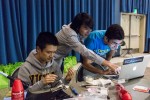Hackathons are events in which participants collaborate as teams to work on software or hardware projects under a time limit, and they have been growing in popularity across the country and at UCLA. Reporter David Gauch presents a behind-the-scenes look at IDEA Hacks hosted by UCLA over the weekend.
—
TRANSCRIPT:
GAUCH: Hackathons are events in which participants collaborate as teams to work on software or hardware projects under a time limit, and they have been growing in popularity across the country and at UCLA. From LA Hacks in Pauley last year, to IDEA Hacks this past weekend in Ackerman Union’s Grand Ballroom, hackathons present opportunities for participants to hone their software and hardware development skills.
The energy in the room is palpable as 200 students are buried in computer screens, while others connect microprocessors to various types of sensors. IDEA Hacks is the first hackathon focusing on hardware on the West Coast, held by UCLA’s Theta Tau and Institute of Electrical and Electronics Engineers. I was there as the teams were let loose at the start of a 36 hour time-frame from 9 p.m. Friday to 9 a.m. Sunday. I started the evening on Friday by gauging a few of the 25 teams’ mindsets going into the competition.
“We already have our main idea down, we’re just trying to figure out how to implement all these tools.”
“We have no idea right now; we have to figure out our plan. All of our team isn’t even here yet.”
“We’re gonna cream everybody else, so you can go ahead and see us on the winners stand.”
GAUCH: When second-year mechanical engineering student Sean Oh attended LA Hacks last year, another hackathon organized by UCLA students, he left wanting a hackathon better suited to his talents as an engineer. As a member of Theta Tau, Oh now is one of the lead coordinators of IDEA Hacks. The principle difference between LA Hacks and IDEA is the emphasis on creating hardware: The theme for their hackathon this year is wearable technology.
OH: A typical hackathon is constituted of students bringing their own laptops, sitting at a table and basically typing lines of code over and over again. As fun as that is, we thought it would be cool if we made something. Like a tangible product that you could one day see on the market and say, “Hey! I made that thing.”
GAUCH: Team Lightning Band is made up of fourth-year mechanical engineering student Daniel Kurkek, fourth-year computer science student Austin Martin and fourth-year mechanical engineering student Elliot Plant. Far ahead of other teams, by Saturday night, Team Lightning Band had constructed a basic working prototype of their project. Here’s Martin on how their project works.
MARTIN: What we’re working on is a bracelet that changes colors based on the velocity of your arm. What that means is that when you are dancing up and down at a show, your arm is changing colors based on exactly how you move.
GAUCH: Team Lightning Band moves fast with only three members and finds the hackathon structure to be beneficial when compared to a more rigid corporate structure, as Plant explains to me.
PLANT: We’ve all worked for big companies, and you certainly see innovation, but you never see this much innovation in such a short time.
GAUCH: The teams work against the clock through the night. While here, students have access to food, tools and even corporate representatives from Deezmaker and Autodesk to help them realize their projects. And that’s not all. It’s completely free. Here’s Sean Oh again.
OH: We do whatever we can to get funding, all the tools that a person might need. We want to provide absolutely everything to them.
GAUCH: It’s 10 a.m. on Sunday and it’s been 37 hours since the event began. No more programming, no more soldering, no more 3D printing. The judges are here and the teams are to be judged. Team Lightning Band is ready to present and has expanded its LED Wristband’s cababilities since Saturday night.
PLANT: Check this out, when we fist bump they change colors.
GAUCH: There were five judges in attendance. Evaluating each team on —
SZETO: Their completion, their pitch, the practicality of their product and whether it was feasible to take to market.
GAUCH: That’s Leo Szeto, a Ride Controls Engineer at Walt Disney Imagineering and UCLA alumni. He is one of the judges at the Hackathon. After the judges scores are tallied, the teams gather by the stage with anticipation for Sean Oh’s announcement of the winning team.
OH: First place goes out to Team 11 for Lighting Band.
SZETO: What the wristband team did was they created something simple that was feasible within the time frame given. And then they were also able to give a vision moving forward as to how this could become useful in someone’s everyday life.
GAUCH: That was Leo Szeto again. After its win, Team Lightning Band will continue to work on its idea beyond the hackathon with the hopes of turning its prototype into a product.
PLANT: We’re definitely thinking of launching a Kickstarter, hopefully getting some money for this and then letting the whole world buy up our eye candy.
GAUCH: If you missed out on participating in this years IDEA hardware hackathon don’t worry, Sean says they’ll be back next year with the hopes of growing the event in numbers and diversity of majors.
OH: You don’t have to be an engineer to attend a hackathon. You can be an art student, a business student, a science student or an engineering student.
GAUCH: Sean says that when students with different majors from north and south campus come together, they can create some of the most exciting and innovative projects. If this story inspires you to get out there and hack and you can’t wait for next year, LA Hacks will be back in Pauley Pavillion this April.
For Daily Bruin Radio, I’m David Gauch.
